Blending your own antioxidant-packed rooibos tea at home is a rewarding and health-boosting experience. Start with high-quality loose leaf rooibos as your base, then experiment with complementary herbs and spices like cinnamon, ginger, or vanilla. You'll need basic tools like a tea infuser, kitchen scale, and airtight containers for storage. Measure carefully, aiming for a 1:4 ratio of herbs to rooibos, and adjust to taste. Brew your custom blend at 95°C (203°F) for 5-7 minutes, or try cold brewing for a smoother flavor. Don't forget to explore natural sweeteners and food pairings to enhance your homemade rooibos creations. The possibilities are as endless as they are delicious.
What Is Rooibos Tea
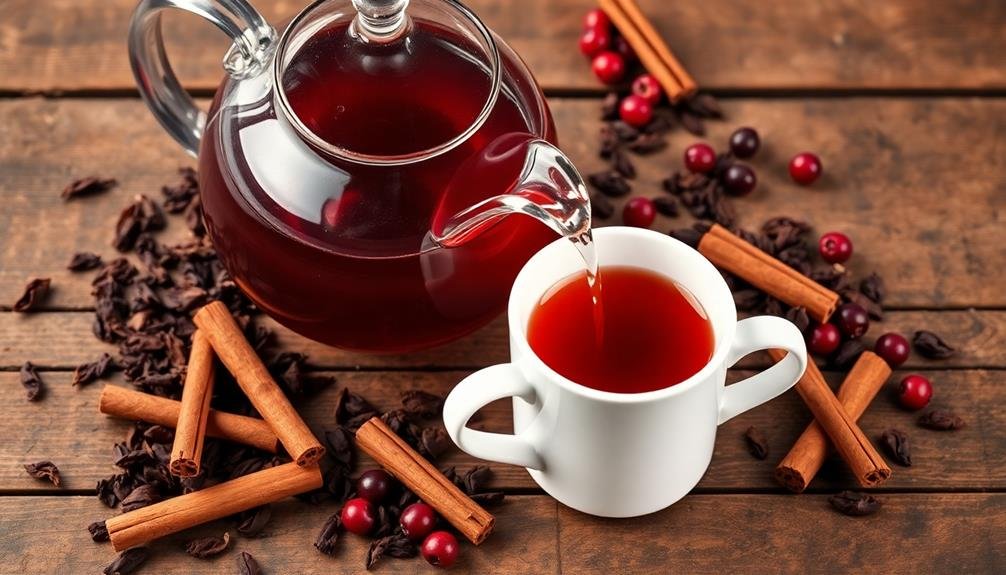
Imagine sipping a warm, reddish-brown brew with a slightly sweet and nutty flavor. That's rooibos tea, a caffeine-free herbal infusion from South Africa.
Unlike traditional teas, rooibos isn't made from the Camellia sinensis plant. Instead, it comes from the leaves of the Aspalathus linearis shrub, native to the Western Cape province.
Rooibos, which means "red bush" in Afrikaans, has been consumed for centuries by indigenous people in South Africa. It's gained global popularity due to its unique taste and potential health benefits.
The tea is rich in antioxidants, particularly aspalathin, which isn't found in other plants.
You'll find rooibos in two main varieties: red and green. Red rooibos undergoes oxidation, giving it its characteristic color and fuller flavor. Green rooibos is unoxidized, retaining more antioxidants and offering a milder taste.
Both types are naturally caffeine-free, making them suitable for evening consumption or for those sensitive to caffeine.
When brewing rooibos, you'll notice it doesn't become bitter like traditional teas, even with extended steeping.
This versatility makes it an excellent base for blending with other herbs and flavors.
Health Benefits of Rooibos
Rooibos tea offers a wealth of potential health benefits, making it an attractive choice for health-conscious individuals. This caffeine-free beverage is rich in antioxidants, particularly aspalathin, which may help protect cells from damage caused by free radicals.
You'll find that rooibos tea can support heart health by potentially lowering blood pressure and improving cholesterol levels. The tea's anti-inflammatory properties may also help manage conditions like diabetes and reduce the risk of certain cancers.
If you're looking to boost your bone health, rooibos contains minerals like calcium, manganese, and fluoride that contribute to stronger bones and teeth. It's also been linked to improved skin health, thanks to its alpha-hydroxy acid and zinc content.
For those struggling with sleep issues, rooibos tea can be a soothing nighttime drink that may help improve sleep quality. Its low tannin content makes it gentler on the stomach compared to traditional teas, potentially aiding digestion.
Additionally, rooibos tea supports the immune system with its high vitamin C content. By incorporating this versatile tea into your daily routine, you're taking a simple step towards better overall health and well-being.
Essential Tools for Blending
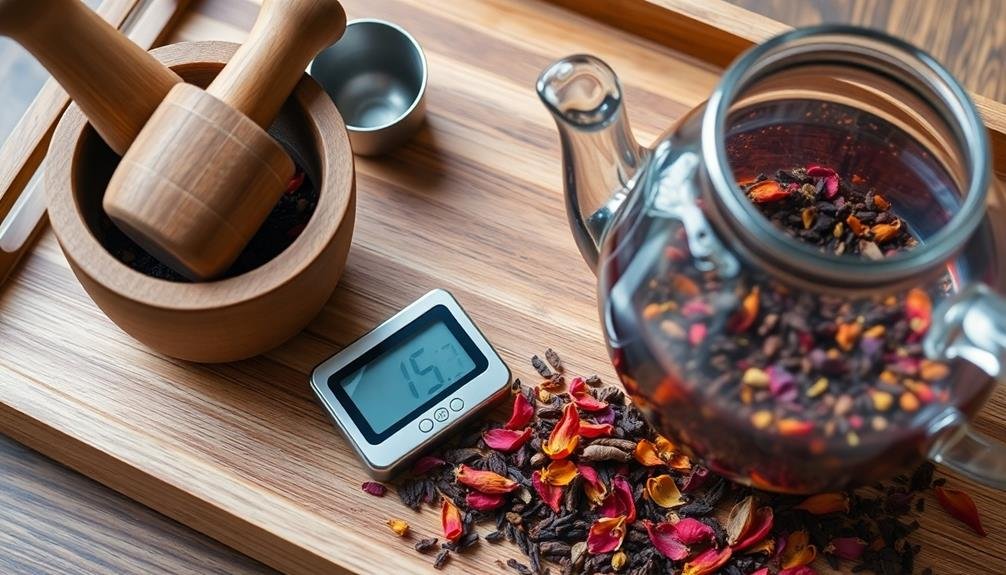
To create your perfect cup of rooibos tea, you'll need a few essential tools for blending. Start with a high-quality tea infuser or strainer to hold your loose rooibos leaves. Opt for a fine-mesh stainless steel infuser to prevent small particles from escaping into your brew.
Invest in an electric kettle with temperature control to heat water to the ideal 200°F (93°C) for rooibos. A kitchen scale is vital for measuring precise amounts of tea leaves, typically 1 gram per 100ml of water. Don't forget a timer to guarantee proper steeping, usually 5-7 minutes for rooibos.
For blending flavors, you'll need airtight containers to store your custom mixes and preserve freshness. A mortar and pestle can help crush dried fruits or spices to release their flavors. Consider a small whisk or frother for thoroughly mixing powdered ingredients like matcha or spices into your rooibos blend.
Lastly, a glass or ceramic teapot allows you to watch the rich, red color develop as your rooibos steeps.
With these tools, you're well-equipped to experiment and create unique, antioxidant-rich rooibos blends tailored to your taste preferences.
Selecting Quality Rooibos Base
When selecting your rooibos base, you'll need to decide between organic and conventional options.
You'll also want to contemplate whether loose leaf or teabags better suit your brewing preferences.
Your choice will impact the flavor, convenience, and overall quality of your homemade rooibos tea blends.
Organic vs. Conventional Rooibos
Many tea enthusiasts face a choice between organic and conventional rooibos when selecting their base for homemade blends.
Organic rooibos is grown without synthetic pesticides or fertilizers, guaranteeing a more natural product. It's often perceived as healthier and may have a slightly richer flavor profile. However, organic rooibos typically comes with a higher price tag.
Conventional rooibos, on the other hand, is more widely available and usually less expensive. While it may involve the use of pesticides, strict regulations guarantee that any residues are within safe limits. The taste difference between organic and conventional rooibos can be subtle, and many drinkers don't notice a significant variation.
When deciding between the two, consider your priorities. If you're deeply committed to organic products and don't mind paying extra, organic rooibos might be your best choice.
However, if you're on a budget or can't easily source organic options, conventional rooibos still offers excellent quality and health benefits.
Ultimately, both types can serve as excellent bases for your homemade rooibos blends, so choose the option that aligns best with your values and preferences.
Loose Leaf or Teabags
Choosing between loose leaf rooibos and teabags is another crucial decision for your homemade blends.
Loose leaf rooibos offers superior quality and flavor, as the leaves are typically whole or minimally processed. This allows for better expansion during steeping, resulting in a richer taste and more potent antioxidant content. You'll also have greater control over the strength of your brew and can easily adjust the amount of tea used.
On the other hand, teabags provide convenience and portability. They're pre-measured and require less preparation time. However, many teabags contain lower-quality rooibos that's been finely ground or made from dust and fannings. This can lead to a less nuanced flavor profile and potentially fewer health benefits.
If you opt for loose leaf, invest in a good tea infuser or strainer for easy brewing. For teabags, look for pyramid-shaped or larger bags that allow more room for the leaves to expand.
Whichever form you choose, verify it's fresh and stored properly to maintain its quality. Remember, the base rooibos you select will considerably impact the final taste of your custom blends.
Complementary Herbs and Spices

To elevate your rooibos tea experience, consider pairing it with complementary herbs and spices. These additions can enhance the flavor profile and boost the health benefits of your brew. Experiment with different combinations to find your perfect blend.
Some popular herbs and spices that work well with rooibos include:
| Herb/Spice | Flavor Profile | Health Benefits |
|---|---|---|
| Cinnamon | Warm, sweet | Anti-inflammatory |
| Ginger | Spicy, zesty | Digestive aid |
| Vanilla | Sweet, creamy | Antioxidant |
| Lemongrass | Citrusy, invigorating | Stress relief |
| Mint | Cool, revitalizing | Digestive support |
When blending, start with a 1:4 ratio of herbs or spices to rooibos. You can adjust this ratio to suit your taste preferences. For a more intense flavor, crush whole spices before adding them to your tea.
Don't forget about fruit additions like dried apple, orange peel, or berries. These can add natural sweetness and a burst of flavor to your rooibos blend. Remember to store your custom blends in airtight containers away from light and moisture to preserve their freshness and potency.
Flavor Combinations to Try
Ready to take your rooibos tea experience to the next level? Experiment with these flavor combinations to create unique and delicious blends.
Try mixing rooibos with cinnamon and orange peel for a warming, citrusy cup. For a soothing bedtime brew, combine rooibos with chamomile and lavender. If you're craving something sweet, add vanilla bean and a touch of stevia to your rooibos base.
For a revitalizing iced tea, blend rooibos with mint and lemon balm. Spice lovers can create a chai-inspired mix by adding cardamom, ginger, and black pepper to their rooibos. If you're looking for a fruity twist, combine rooibos with dried berries like strawberries, blueberries, or raspberries.
For a rich, dessert-like flavor, mix rooibos with cacao nibs and a hint of coconut.
Don't be afraid to get creative with your combinations. Start with small batches to test your blends, and adjust the ratios to suit your taste preferences.
Remember that rooibos has a naturally sweet, nutty flavor that pairs well with a wide range of ingredients, so let your imagination guide you in crafting your perfect cup.
Measuring and Mixing Techniques

Accurate measuring and proper mixing are key to creating the perfect cup of rooibos tea. Start by using a precise kitchen scale to weigh your tea leaves, aiming for about 1 gram of loose rooibos per 100ml of water. If you don't have a scale, use a teaspoon measure, with one heaping teaspoon per cup. For cold brewing, double the amount of tea leaves.
When it comes to mixing, follow these steps for the best results:
- Heat your water to just below boiling (around 95°C or 203°F) for hot brews, or use room temperature water for cold brews.
- Place your measured tea leaves in an infuser or directly in your pot or cup.
- Pour the water over the leaves and let it steep for 5-7 minutes for hot tea, or 6-12 hours for cold brew.
Stir gently once or twice during the steeping process to guarantee even distribution of flavors. If you're adding herbs or spices, incorporate them at the beginning of the steeping process. For sweeteners or milk, add them after brewing to taste.
Proper Storage of Blended Tea
To keep your blended rooibos tea fresh and flavorful, you'll need to store it properly.
Always use airtight containers to protect the tea from moisture and odors.
Place these containers in a cool, dark location away from direct sunlight and heat sources to preserve the tea's quality and extend its shelf life.
Airtight Containers Essential
Preserving the flavor and freshness of your blended rooibos tea requires proper storage. Airtight containers are essential for maintaining the quality of your homemade tea blend. When exposed to air, moisture, and light, your carefully crafted mix can quickly lose its potency and taste.
To guarantee your rooibos blend stays fresh for months, invest in high-quality, opaque containers with tight-fitting lids. Choose containers made of materials that won't impart unwanted flavors or odors to your tea. Glass, ceramic, or food-grade stainless steel are excellent options. Avoid plastic containers, as they can absorb and transfer flavors over time.
When storing your blended rooibos tea, remember these key points:
- Keep containers in a cool, dry place away from direct sunlight
- Fill containers as full as possible to minimize air exposure
- Label your blends with the date and ingredients for easy reference
Cool, Dark Location
Consistently storing your blended rooibos tea in a cool, dark location is essential for maintaining its quality and flavor. Heat, light, and moisture can quickly degrade the delicate compounds in your tea, diminishing its taste and health benefits.
Choose a pantry, cupboard, or shelf away from direct sunlight and heat sources like stoves or radiators. Aim for a storage area with a stable temperature between 60-70°F (15-21°C).
Avoid refrigerating your tea, as the humidity can introduce moisture and potentially compromise its freshness. If you live in a particularly warm or humid climate, consider using a dedicated tea cabinet with humidity control.
Keep your tea away from strong odors, as it can absorb surrounding scents. Don't store it near spices, coffee, or other aromatic items.
If possible, dedicate a separate space solely for your tea collection.
Brewing Your Custom Rooibos Blend

Once you've created your custom rooibos blend, brewing it to perfection is the next essential step. Start by heating fresh, filtered water to just below boiling point, around 200°F (93°C). This temperature allows the rooibos to release its full flavor without becoming bitter.
For every 8 ounces of water, use 1 to 1.5 teaspoons of your custom blend. Place your blend in a tea infuser or filter, then pour the hot water over it. Let it steep for 5 to 7 minutes, depending on your preferred strength. Remember, rooibos doesn't become bitter with longer steeping times, so you can experiment to find your ideal brew.
To enhance your rooibos experience, try these variations:
- Iced rooibos: Brew a strong concentrate and pour over ice
- Rooibos latte: Add steamed milk and a touch of honey
- Sun-brewed rooibos: Steep in cold water for 4-6 hours in sunlight
After brewing, you can store your rooibos tea in the refrigerator for up to 48 hours. This allows you to enjoy your custom blend hot or cold throughout the day, maximizing its antioxidant benefits and unique flavor profile.
Hot vs. Iced Rooibos
Versatility is one of rooibos tea's greatest strengths, shining in both hot and iced preparations. When brewing hot rooibos, steep it for 5-7 minutes in water that's just off the boil. This method extracts the tea's full flavor profile, highlighting its nutty, slightly sweet taste. You'll notice a rich, red color and a smooth mouthfeel.
Hot rooibos is perfect for chilly days or as a caffeine-free alternative to your morning coffee.
For iced rooibos, you've got two options. The first is to brew it hot and then chill it. This method preserves the tea's robust flavor but requires planning ahead.
Alternatively, you can cold brew rooibos by steeping it in cold water for 8-12 hours in the refrigerator. This technique yields a smoother, less tannic taste that's ideal for revitalizing summer drinks.
Both hot and iced rooibos offer health benefits, including antioxidants and minerals. The choice between hot and cold often comes down to personal preference and the occasion.
Experiment with both to find your favorite way to enjoy this versatile South African tea.
Enhancing Flavor With Natural Sweeteners
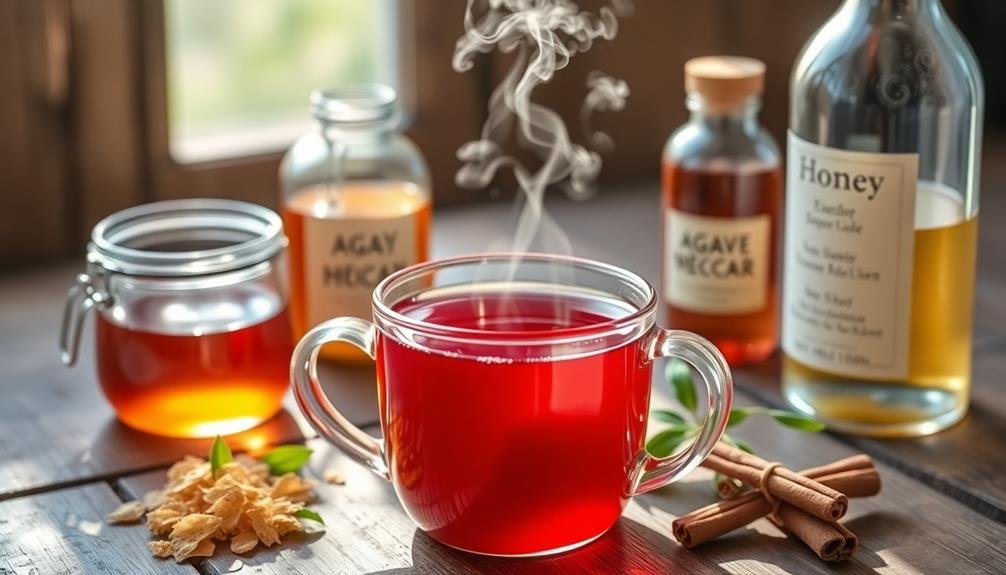
Many rooibos tea enthusiasts enjoy enhancing their brew's natural flavor with a variety of sweeteners. If you're looking to add a touch of sweetness to your rooibos without resorting to refined sugar, there are several natural options to explore.
Honey is a popular choice, offering a rich, complex sweetness that complements rooibos's earthy notes. You'll find that a small amount goes a long way in enhancing the tea's flavor profile.
For a vegan alternative, agave nectar provides a similar sweetness with a lighter taste.
If you're feeling adventurous, try these unique natural sweeteners:
- Stevia leaves: Add a few fresh or dried leaves to your brew for a calorie-free sweetness
- Date syrup: Drizzle in this rich, caramel-like sweetener for a depth of flavor
- Maple syrup: Use a small amount to impart a subtle, woody sweetness
Pairing Rooibos With Food
With its smooth, nutty flavor profile, rooibos tea pairs wonderfully with a variety of foods. You'll find it complements both sweet and savory dishes, making it a versatile choice for any meal.
For breakfast, try sipping rooibos alongside a hearty bowl of oatmeal topped with fresh berries and nuts. The tea's natural sweetness enhances the flavors of the fruit while balancing the earthy notes of the oats.
When it comes to lunch and dinner, rooibos pairs exceptionally well with grilled meats and roasted vegetables. Its subtle caramel undertones can bring out the rich flavors of a perfectly seared steak or add depth to a plate of roasted root vegetables.
For a lighter option, try pairing rooibos with a fresh salad dressed in a citrus vinaigrette.
Don't forget about dessert! Rooibos tea is an excellent companion to chocolate-based treats, as its nutty notes complement the cocoa's richness.
It also pairs beautifully with fruit tarts, vanilla-flavored desserts, and even cheese plates. For a unique twist, try infusing rooibos into baked goods or using it as a base for homemade ice cream.
Gifting Your Homemade Blends

Creating your own rooibos tea blends isn't just enjoyable for personal consumption—it's also a thoughtful and unique gift idea. Your friends and family will appreciate the time and effort you've put into crafting a personalized tea experience.
When preparing your homemade blends as gifts, consider packaging them in attractive, airtight containers to preserve freshness and flavor.
To make your rooibos tea gifts even more special, try these ideas:
- Create custom labels with the blend name, ingredients, and brewing instructions
- Include a small measuring spoon or infuser with each gift
- Pair your tea blend with a matching mug or teacup
Don't forget to provide information about the health benefits of rooibos tea, such as its high antioxidant content and caffeine-free nature. You can also suggest food pairings or ideal times of day to enjoy the blend.
If you've created multiple blends, consider putting together a sampler set with small portions of each. This allows the recipient to explore different flavor combinations and find their favorite.
Frequently Asked Questions
Can Pregnant Women Safely Drink Rooibos Tea?
Yes, you can safely drink rooibos tea during pregnancy. It's caffeine-free and rich in antioxidants, which may benefit both you and your baby. However, it's always best to consult your doctor before adding any new beverages to your diet.
How Does Rooibos Tea Compare to Green Tea in Caffeine Content?
You'll find rooibos tea is naturally caffeine-free, unlike green tea which contains caffeine. If you're looking to reduce your caffeine intake, rooibos is a great alternative that won't give you the jitters.
Is Rooibos Tea Suitable for People With Iron Deficiency?
You'll be pleased to know that rooibos tea is suitable for people with iron deficiency. It's naturally caffeine-free and doesn't contain tannins, which can inhibit iron absorption. In fact, it may even enhance iron uptake in your body.
Can Rooibos Tea Stain Teeth Like Black Tea Does?
You'll be glad to know that rooibos tea won't stain your teeth like black tea does. It's naturally low in tannins, which are responsible for staining. You can enjoy your rooibos without worrying about tooth discoloration.
Does Rooibos Tea Have Any Potential Side Effects or Interactions?
You'll be glad to know rooibos tea generally has few side effects. However, it might interact with some medications or cause liver problems in rare cases. It's best to consult your doctor if you're concerned.
In Summary
You're now equipped to create your own antioxidant-rich rooibos blends at home. With your newfound knowledge of rooibos's health benefits, essential tools, and complementary ingredients, you'll be crafting unique teas in no time. Whether you prefer hot or iced, sweetened or plain, there's a rooibos blend for every palate. Don't forget to share your creations with friends and family – your homemade rooibos blends make perfect gifts. Start experimenting today and enjoy the endless possibilities of this versatile tea.


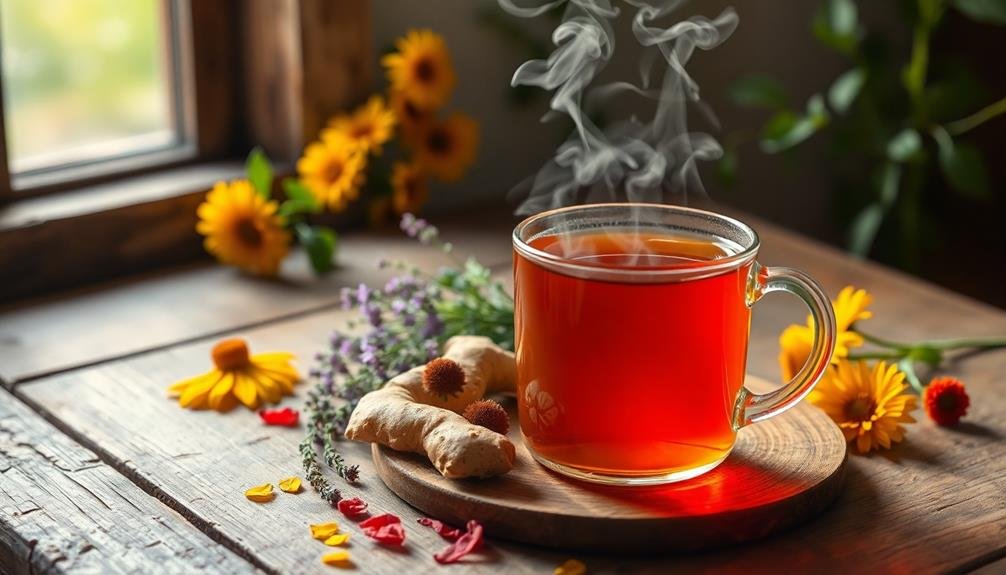
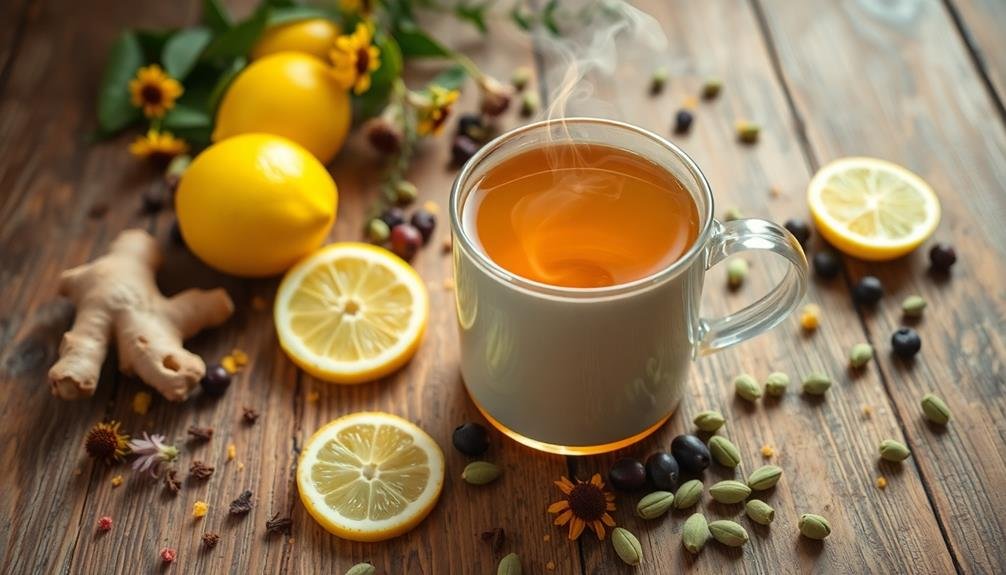
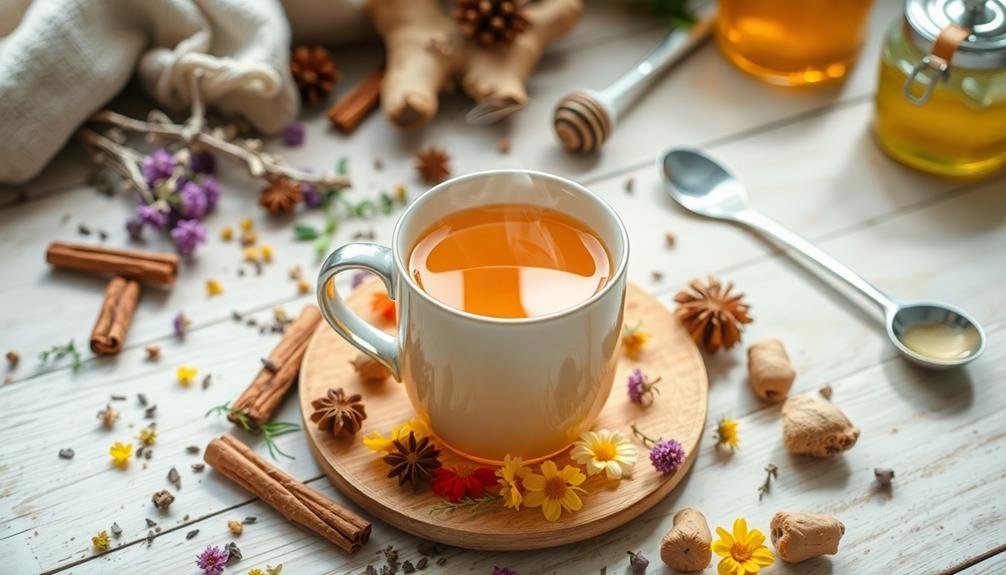
Leave a Reply